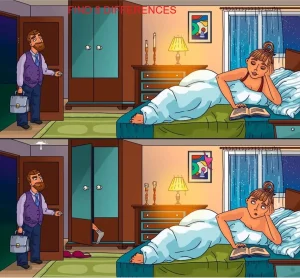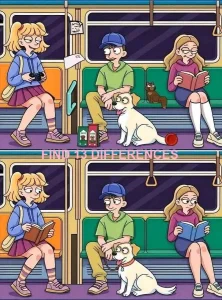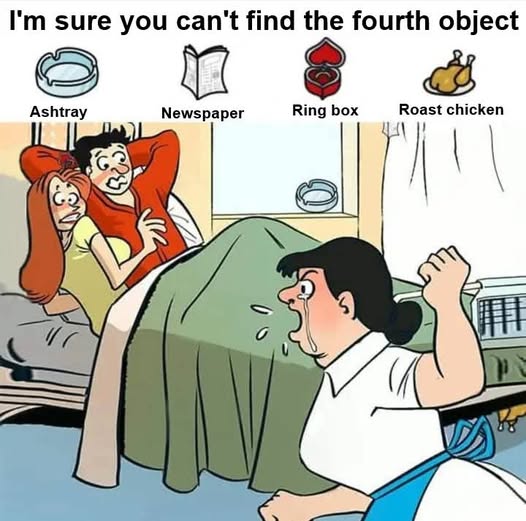The Challenge of Hidden Objects: A Fun Brain Teaser
At first glance, some images may seem to convey a straightforward narrative, but upon closer examination, they conceal a challenging puzzle waiting to be unraveled. Today, we present a stimulating brain teaser that will not only engage your mind but also test your observational skills to the utmost. This particular puzzle is a prime example of a “hidden object” challenge, cleverly designed to trick even the most astute observers. What appears to be a light-hearted cartoon scene is, in fact, a complex visual conundrum. 📸

Understanding the Scene
In this engaging illustration, we find ourselves in a chaotic bedroom setting. A furious woman bursts into the room, her fist clenched in a gesture of confrontation, clearly indicating a moment of high tension. Her expression is one of anger, leaving little doubt about her intentions. Illustrations like this often use exaggerated emotions to exaggerate the visual narrative, a tactic employed by artists to draw the viewer’s attention to the scene while simultaneously distracting them from the hidden elements within it.
On the bed, a startled man and a red-haired woman stare wide-eyed, caught completely off guard by the unexpected arrival. Their shocked expressions resonate with the viewer, reflecting the chaos that typically accompanies such unexpected confrontations. However, the narrative itself is not the primary focus of this puzzle. Instead, the true challenge lies in the minute details that have been cleverly disguised throughout the scene. The juxtaposition of emotions and hidden objects creates a layered narrative that encourages deeper exploration, inviting the viewer not only to observe but also to analyze.

Your Quest: Locate the Hidden Objects
Your mission, should you choose to accept it, is to locate four specific objects that have been artfully camouflaged within the image. At first, it might seem like a simple task, but appearances can be deceiving. The objects hidden in the image are:
Ashtray
Newspaper
Ring Box
Roast Chicken
It may sound easy, but many who attempt this puzzle end up overlooking at least one of these hidden treasures! The excitement and frustration often stem from the challenges posed by these elusive items, making the pursuit all the more thrilling. 🔍

Step-by-Step Guide to Finding the Objects
Ashtray: This object is arguably the easiest of the four to spot. Look closely at the windowsill behind the bed; the ashtray’s clear, rounded shape makes it distinct, provided you’re attentive to your surroundings. This highlights the importance of perspective in puzzles, as sometimes the most obvious objects are the hardest to notice due to placement. Newspaper: Don’t underestimate this sneaky item! It has been cleverly integrated into the top edge of the white curtain on the right side of the image. The newspaper’s grayish hue blends almost perfectly with the fabric, making it a challenge to find unless you meticulously scan every inch of the scene. This particular item is a perfect example of how color can play tricks on the eyes. Ring Box: For this item, you’ll need to direct your attention to the red hair of the woman on the bed. A small heart-shaped design is cleverly hidden within her hairstyle, representing the ring box. Its placement is so subtle that it requires a discerning eye to notice. This serves as a reminder of how everyday objects can become part of a larger visual tapestry. Roast Chicken: The most elusive of the bunch! This delicious item lies beneath the bed, near the feet of the enraged woman. Shaded in warm brown tones, it is deliberately camouflaged with the darker area under the bed, making it difficult to detect at first glance. The darker visuals beneath the bed symbolize how easy it is to overlook what is literally beneath our feet.
Reflections on the Challenge
This brain teaser is not just a trivial pursuit; it serves as a profound test of your visual acuity, attention to detail, and spatial reasoning. The emotional turmoil depicted in the scene can easily distract the viewer. However, to successfully uncover the hidden objects, one must focus solely on the lines, colors, and shapes that seem slightly out of place. Engaging with this puzzle can be compared to the art of detective work, where every detail matters, and missing one clue can change the entire outcome. If you managed to find all four hidden items, congratulations! You possess the keen observation skills of a seasoned detective. However, if you missed one or more, don’t be discouraged. Armed with the knowledge of where these items are located, take a moment to revisit the image. You may be surprised to see how effectively they were disguised right before your eyes.
Final Thoughts: The Joy of Discovery
The world of hidden object puzzles is filled with intrigue and delight. They challenge us to hone our observation skills while also providing a fun and engaging way to pass the time. Participating in these challenges not only sharpens cognitive functions but also enhances our patience and concentration, which are invaluable skills in today’s fast-paced world. As you reflect on this puzzle, consider the mental exercises that come into play when navigating such challenges—perception, focus, and critical thinking are all essential components of the experience. So, how many of the hidden items did you uncover without peeking at the solutions? Each discovery adds to the thrill of the pursuit, reminding us that sometimes, the most significant treasures are hidden in plain sight.
In conclusion, engaging with hidden object puzzles is more than just a pastime; it becomes a celebration of the meticulous art of observation. It encourages individuals to cultivate a keen eye and develop a sense of curiosity about the world around them.
So next time you stumble upon a visual puzzle, take a moment to dive deep into its layers. After all, the joy of discovery lies in the journey.


